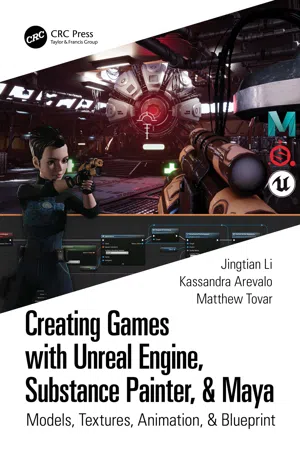
Creating Games with Unreal Engine, Substance Painter, & Maya
Models, Textures, Animation, & Blueprint
Kassandra Arevalo, Matthew Tovar, Jingtian Li
- 802 páginas
- English
- ePUB (apto para móviles)
- Disponible en iOS y Android
Creating Games with Unreal Engine, Substance Painter, & Maya
Models, Textures, Animation, & Blueprint
Kassandra Arevalo, Matthew Tovar, Jingtian Li
Información del libro
Description:
This tutorial-based book allows readers to create a first-person game from start to finish using industry-standard (and free to student) tools of Maya, Substance Painter, and Unreal Engine. The first half of the book lays out the basics of using Maya and Substance Painter to create game-ready assets. This includes polygonal modeling, UV layout, and custom texture painting. Then, the book covers rigging and animation solutions to create assets to be placed in the game including animated first-person assets and motion-captured NPC animations. Finally, readers can put it all together and build interactivity that allows the player to create a finished game using the assets built and animated earlier in the book.
• Written by industry professionals with real-world experience in building assets and games.
• Build a complete game from start to finish.
• Learn what the pros use: construct all assets using the tools used at industries across the world.
• All software used are free to students.
• When complete, students will have a playable version of an FPS game.
Jing Tian Li is a graduate of China's Central Academy of Fine Arts and New York's School of Visual Arts, where he earned an MFA in Computer Art. He currently is an Assistant Professor of 3D Animation & Game Design at the University of the Incarnate Word in San Antonio, Texas.
Kassandra Arevalo is an instructor of 3D Animation & Game Design at the University of the Incarnate Word in San Antonio, Texas. She previously worked as an animator at Immersed Games.
Matt Tovar is an industry veteran animator. He has worked at Naughty Dog, Infinity Ward, and Sony Interactive on such games as The Last of Us, Call of Duty: Modern Warfare, and most recently Marvel's Avengers with Crystal Dynamics. He is an Assistant Professor of 3D Animation at the University of the Incarnate Word in San Antonio, Texas.
Preguntas frecuentes
Información
CHAPTER 1
Maya Modeling
Basics of Navigation

Rendering
What is a 3D Model?
Translation
Anatomy of a Model
Edge
Vertex
Face
Object Mode
Normal
Índice
- Cover
- Half Title
- Title Page
- Copyright Page
- Dedication Page
- Table of Contents
- Acknowledgments
- Authors
- Introduction
- Chapter 1: Maya Modeling
- Chapter 2: Maya Set UV
- Chapter 3: Set Texturing
- Chapter 4: Level Asset Creation
- Chapter 5: Level Creation
- Chapter 6: Lighting and Baking
- Chapter 7: Character Modeling
- Chapter 8: UV Mapping
- Chapter 9: Character Texture Painting
- Chapter 10: Rigging
- Chapter 11: FPS Animation in Maya
- Chapter 12: Unreal Character Asset Creation
- Chapter 13: Basics of Programming
- Chapter 14: Player Character
- Chapter 15: Weapons
- Chapter 16: Health and Damage
- Chapter 17: Inventory and UI
- Chapter 18: Security Camera
- Chapter 19: Patrolling AI
- Chapter 20: Boss
- Chapter 21: Audio and VFX
- Chapter 22: Packaging
- Index